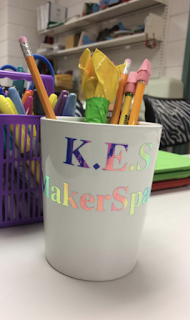Recently I overheard a group of teachers planning a maker sequence and trying to figure out where to make space in the sequence to explain design thinking to the children. I immediately was reminded of the times where I had spent too much time talking about design thinking instead of having the students experience design thinking and learning the stages by 'doing them.
While designing a maker experience for Beeman Elementary School, I decided to spend less time TALKING about design thinking and more time integrating the concepts and language used in Design Thinking into the maker sequence. But even though my goal was to integrate design thinking language and practices into the maker event instead of spending lots of time talking about the different stages, I still wanted the students to leave familiar with the stages and what they looked like. Here is how I approached my goal.
First I made a large poster of Design Thinking stages that also included examples of what each phase might look like.
Next I used each stage of the design thinking process to plan the sequence of activities that I would lead students through.

In the case of this maker experience, I modeled using HOW MIGHT WE language when I described our goal for the day.
In our case they knew they were going to build a wind tunnel, but there was still room for the Empathy stage to learn more about who might be using the Wind tunnel they would build and what that interaction might look like. YouTube is filled with videos you could use to increase empathy in this first stage of design thinking. Here is the video I used to give student the opportunity to OBSERVE students using a Wind Tunnel.
EMPATHY stage:
- Ask questions
- Make observations
- Gather information
- Empathize: Understand the feelings, needs, and concerns of another
In our Beeman Maker Event, we used the following template to help each create a HOW MIGHT WE statement for the Wind Tunnel we were about to build.
DEFINE stage:
How Might We ____________________ (create/make/design)
For _____________ (describe who you are making for)
That ____________ (what specific needs/wants do these users have)
That ____________ (will we be using a certain tool, process, or improved system)For _____________ (describe who you are making for)
That ____________ (what specific needs/wants do these users have)
That ____________ (constraints/ limitation - cost, material, time)
IDEATE stage
In the IDEATE phase, we asked the students to sketch some ideas for a protoptye they might build. Lots of stickynotes can be very helpful. They often think they are done and as facilitator use the word AND to try to get them to keep the conversation forward. Have the students share their ideas by posting the sticky notes on to wall or bulletin board and perhaps grouping like ones together.
PROTOTYPE stage:
Next comes the fun part, where the students have access to tools and materials to build a prototyped.

TEST and Revise stage:
In the case of making our wind tunnel, the students got to observe several other classes test their newly constructed Wind Tunnel.
As we completed each of these steps I made sure to get some photos and videos of each stage, and then put together this short video for us to debrief.
As we watched the video together we were able to discuss the different stages of a design thinking and how each felt to them.
The next time you are tempted to 'lecture" ABOUT design thinking, consider leading students through an exercise where they will experience Design thinking and use visual clues around the room to help them name each stage that they just went through.
The more you use the design thinking protocol, name the stages, and compile evidence of each stage, the more your students will internalize the stages (and you didn't have to 'lecture"
\














































